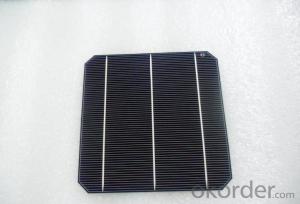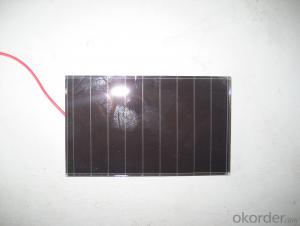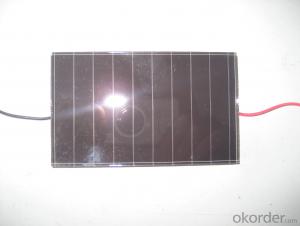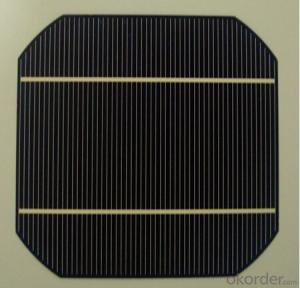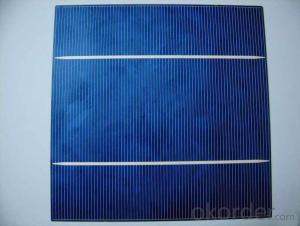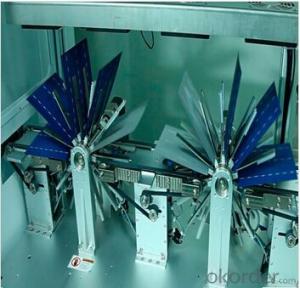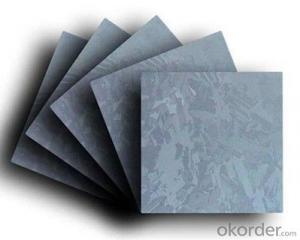Solar Cell High Quality A Grade Cell Monorystalline 5v 17.4%
- Loading Port:
- Shanghai
- Payment Terms:
- TT OR LC
- Min Order Qty:
- 1000 pc
- Supply Capability:
- 100000 pc/month
OKorder Service Pledge
OKorder Financial Service
You Might Also Like
Specifications
hot sale solar cell
1.16.8%~18.25% high efficiency
2.100% checked quality
3.ISO9001/ISO14001/TUV/CE/UL
4.stable performance
We can offer you the best quality products and services, don't miss !
POLY6'(156*156)
Polycrystalline Silicon Solar cell
Physical Characteristics
Dimension: 156mm×156mm±0.5mm
Diagonal: 220mm±0.5mm
Thickness(Si): 200±20 μm
Front(-) Back(+)
Blue anti-reflecting coating (silicon nitride); Aluminum back surface field;
1.5mm wide bus bars; 2.0mm wide soldering pads;
Distance between bus bars: 51mm . Distance between bus bars :51mm .
Electrical Characteristics
Efficiency(%) | 18.00 | 17.80 | 17.60 | 17.40 | 17.20 | 16.80 | 16.60 | 16.40 | 16.20 | 16.00 | 15.80 | 15.60 |
Pmpp(W) | 4.33 | 4.29 | 4.24 | 4.19 | 4.14 | 4.09 | 4.04 | 3.99 | 3.94 | 3.90 | 3.86 | 3.82 |
Umpp(V) | 0.530 | 0.527 | 0.524 | 0.521 | 0.518 | 0.516 | 0.514 | 0.511 | 0.509 | 0.506 | 0.503 | 0.501 |
Impp(A) | 8.159 | 8.126 | 8.081 | 8.035 | 7.990 | 7.938 | 7.876 | 7.813 | 7.754 | 7.698 | 7.642 | 7.586 |
Uoc(V) | 0.633 | 0.631 | 0.628 | 0.625 | 0.623 | 0.620 | 0.618 | 0.617 | 0.615 | 0.613 | 0.611 | 0.609 |
Isc(A) | 8.709 | 8.677 | 8.629 | 8.578 | 8.531 | 8.478 | 8.419 | 8.356 | 8.289 | 8.220 | 8.151 | 8.083 |
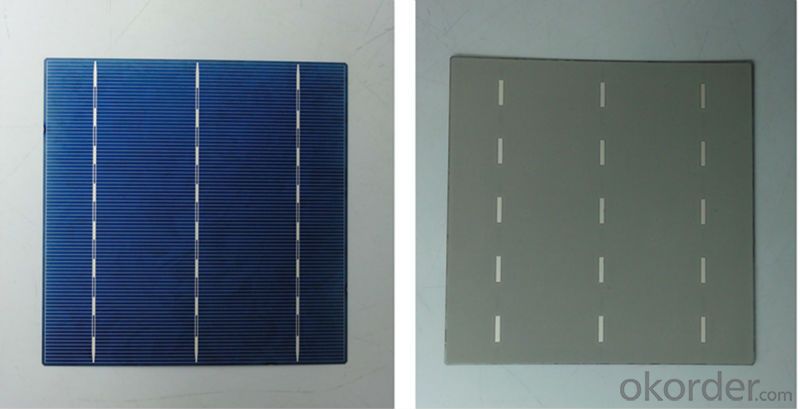
MONO5'(125*125mm)165
Monocrystalline silicon solar cell
Physical Characteristics
Dimension: 125mm×125mm±0.5mm
Diagonal: 165mm±0.5mm
Thickness(Si): 200±20 μm
Front(-) Back(+)
Blue anti-reflecting coating(silicon nitride); Aluminum back surface field;
1.6mmwide bus bars; 2.5mm wide soldering pads;
Distance between bus bars: 61mm . Distance between bus bars :61mm .
Electrical Characteristics
Efficiency(%) | 19.40 | 19.20 | 19.00 | 18.80 | 18.60 | 18.40 | 18.20 | 18.00 | 17.80 | 17.60 | 17.40 | 17.20 |
Pmpp(W) | 2.97 | 2.94 | 2.91 | 2.88 | 2.85 | 2.82 | 2.79 | 2.76 | 2.73 | 2.70 | 2.67 | 2.62 |
Umpp(V) | 0.537 | 0.535 | 0.533 | 0.531 | 0.527 | 0.524 | 0.521 | 0.518 | 0.516 | 0.515 | 0.513 | 0.509 |
Impp(A) | 5.531 | 5.495 | 5.460 | 5.424 | 5.408 | 5.382 | 5.355 | 5.328 | 5.291 | 5.243 | 5.195 | 4.147 |
Uoc(V) | 0.637 | 0.637 | 0.636 | 0.635 | 0.633 | 0.630 | 0.629 | 0.629 | 0.628 | 0.626 | 0.626 | 0.625 |
Isc(A) | 5.888 | 5.876 | 5.862 | 5.848 | 5.839 | 5.826 | 5.809 | 5.791 | 5.779 | 5.756 | 5.293 | 5.144 |

FAQ:
Q:How can i get some sample?
A:Yes , if you want order ,sample is not a problem.
Q:How about your solar panel efficency?
A: Our product efficency around 17.25%~18.25%.
Q:What’s the certificate you have got?
A: we have overall product certificate of ISO9001/ISO14001/CE/TUV/UL
- Q:What is the purpose of a solar silicon wafer in a solar cell?
- The purpose of a solar silicon wafer in a solar cell is to convert sunlight into electricity. The silicon wafer acts as the main component for absorbing photons from the sun, generating an electric current through the photovoltaic effect.
- Q:Are solar silicon wafers recyclable?
- Yes, solar silicon wafers are recyclable. They can be processed and reused to manufacture new solar panels or other products, reducing waste and environmental impact.
- Q:What is the impact of impurity concentration on solar silicon wafers?
- The impurity concentration in solar silicon wafers has a significant impact on their performance and efficiency. Higher impurity concentrations can lead to reduced electrical conductivity, increased recombination of charge carriers, and decreased overall efficiency of the solar cell. It can also affect the material's optical properties, such as light absorption and transmission, further compromising its performance. Therefore, controlling and minimizing impurity concentrations is crucial in ensuring the high-quality and optimal functioning of solar silicon wafers.
- Q:How to calculate the conversion efficiency of monocrystalline silicon
- Proportion of dark current - Irev>6 cell ratioThe proportion of low efficiency tablets - the proportion of P156Eff<14.5% batteries8 inch single crystal conversion rate of about 18.5%; a single conversion rate of about 9 inches in about 18.6%; quasi single crystal (large particles) probably about 18%; the new diamond wire cutting rate can be converted to about 18.92%.
- Q:How are solar silicon wafers protected from extreme weather events?
- Solar silicon wafers are protected from extreme weather events through the use of specialized materials and coatings. These protective layers shield the wafers from moisture, temperature fluctuations, and other environmental factors that could potentially damage them. Additionally, solar panels are designed to withstand high winds and heavy rain, ensuring their resilience during storms and other severe weather conditions.
- Q:How many watts can a piece of silicon produce
- A piece of silicon chip, 156*156 efficiency of 17.4%, a single chip power of about 4.2 watts, that is, under the 1000w/m2 light, power generation is 4,2w, you can calculate the amount of electricity by irradiation time.
- Q:What is the typical production volume of solar silicon wafers?
- The typical production volume of solar silicon wafers can vary depending on the size and capacity of the manufacturing facility. However, large-scale production facilities are capable of producing millions to billions of solar silicon wafers annually to meet the growing demand for solar energy.
- Q:Can solar silicon wafers be used in solar-powered boats?
- Yes, solar silicon wafers can be used in solar-powered boats. These wafers are commonly used to capture sunlight and convert it into electrical energy, making them an ideal choice for powering various applications, including boats. By integrating solar silicon wafers into the design of a solar-powered boat, it becomes possible to harness the sun's energy and use it as a sustainable and renewable power source for propulsion and other electrical systems onboard.
- Q:What are the different doping techniques used in solar silicon wafers?
- There are several doping techniques used in solar silicon wafers, including diffusion, ion implantation, and screen printing. Diffusion involves heating the silicon wafers in the presence of a dopant gas, allowing the dopant atoms to diffuse into the silicon lattice. Ion implantation involves bombarding the silicon wafers with high-energy dopant ions, which get embedded into the silicon lattice. Screen printing involves applying a dopant ink onto the surface of the silicon wafer and then firing it at high temperatures to allow the dopant to diffuse into the silicon. Each of these techniques has its own advantages and limitations, and their selection depends on factors such as cost, efficiency, and desired doping profile.
- Q:Are there any environmental concerns with the production or disposal of solar silicon wafers?
- Yes, there are some environmental concerns associated with the production and disposal of solar silicon wafers. The production of silicon wafers involves energy-intensive processes and the use of hazardous chemicals, which can contribute to air and water pollution if not managed properly. Additionally, the mining of raw materials for silicon wafers can have negative impacts on ecosystems and communities. Proper disposal and recycling of silicon wafers are also important to prevent potential environmental harm. However, it is worth noting that compared to other energy sources, the environmental impact of solar silicon wafers is relatively lower, and advancements in technology and regulations continue to address these concerns.
1. Manufacturer Overview |
|
|---|---|
| Location | |
| Year Established | |
| Annual Output Value | |
| Main Markets | |
| Company Certifications | |
2. Manufacturer Certificates |
|
|---|---|
| a) Certification Name | |
| Range | |
| Reference | |
| Validity Period | |
3. Manufacturer Capability |
|
|---|---|
| a)Trade Capacity | |
| Nearest Port | |
| Export Percentage | |
| No.of Employees in Trade Department | |
| Language Spoken: | |
| b)Factory Information | |
| Factory Size: | |
| No. of Production Lines | |
| Contract Manufacturing | |
| Product Price Range | |
Send your message to us
Solar Cell High Quality A Grade Cell Monorystalline 5v 17.4%
- Loading Port:
- Shanghai
- Payment Terms:
- TT OR LC
- Min Order Qty:
- 1000 pc
- Supply Capability:
- 100000 pc/month
OKorder Service Pledge
OKorder Financial Service
Similar products
New products
Hot products
Related keywords
